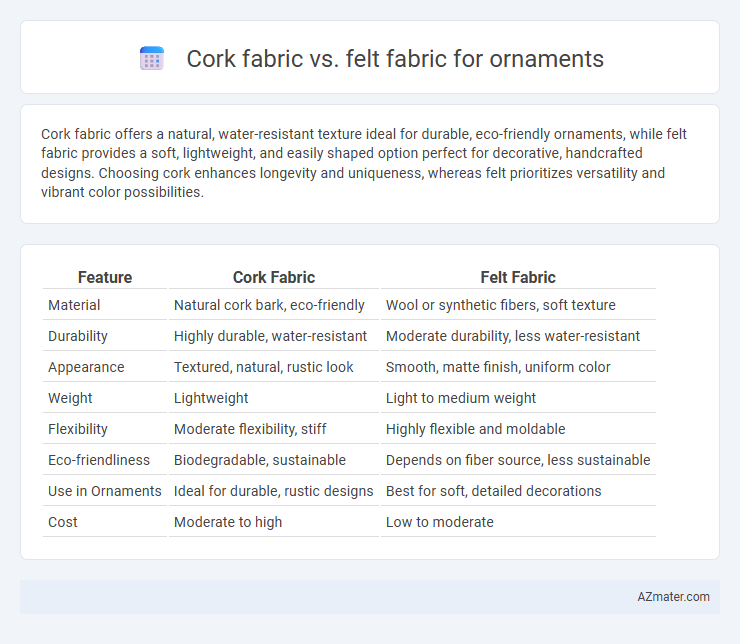Cork fabric offers a natural, water-resistant texture ideal for durable, eco-friendly ornaments, while felt fabric provides a soft, lightweight, and easily shaped option perfect for decorative, handcrafted designs. Choosing cork enhances longevity and uniqueness, whereas felt prioritizes versatility and vibrant color possibilities.
Table of Comparison
| Feature | Cork Fabric | Felt Fabric |
|---|---|---|
| Material | Natural cork bark, eco-friendly | Wool or synthetic fibers, soft texture |
| Durability | Highly durable, water-resistant | Moderate durability, less water-resistant |
| Appearance | Textured, natural, rustic look | Smooth, matte finish, uniform color |
| Weight | Lightweight | Light to medium weight |
| Flexibility | Moderate flexibility, stiff | Highly flexible and moldable |
| Eco-friendliness | Biodegradable, sustainable | Depends on fiber source, less sustainable |
| Use in Ornaments | Ideal for durable, rustic designs | Best for soft, detailed decorations |
| Cost | Moderate to high | Low to moderate |
Overview of Cork Fabric and Felt Fabric
Cork fabric is a sustainable, lightweight material made from the bark of cork oak trees, featuring a smooth texture and water-resistant properties ideal for durable, eco-friendly ornaments. Felt fabric, typically made from compressed wool or synthetic fibers, offers a soft, pliable texture with excellent insulation and easy dyeing traits, making it popular for colorful and decorative ornaments. Both materials provide unique aesthetic and functional benefits, with cork fabric emphasizing natural resilience and felt fabric focusing on versatility and texture.
Key Material Properties: Cork vs Felt
Cork fabric offers durability, water resistance, and natural elasticity, making it ideal for ornaments that require flexibility and moisture protection. Felt fabric provides a soft texture, excellent insulation, and ease of shaping, suitable for decorative ornaments needing a plush feel and simple crafting. Both materials serve unique aesthetic and functional purposes, with cork excelling in resilience and felt in softness.
Sustainability and Eco-Friendliness Comparison
Cork fabric is a highly sustainable material derived from the bark of cork oak trees, which regenerates naturally without harming the tree, making it biodegradable and recyclable for eco-friendly ornament production. Felt fabric, often made from synthetic fibers, raises environmental concerns due to its non-biodegradable nature and energy-intensive manufacturing process, although natural wool felt offers a more sustainable but less durable alternative. Cork's renewable source and lower carbon footprint position it as a superior eco-friendly choice over traditional felt for decorative ornaments.
Durability and Longevity in Ornament Use
Cork fabric offers superior durability and resistance to wear when used in ornaments, maintaining its structural integrity and appearance over extended periods. Felt fabric, while soft and pliable, tends to show signs of fraying and compression more quickly, reducing its longevity in decorative applications. The natural resilience and water-resistant properties of cork enhance ornament longevity, making it a more durable choice compared to felt.
Texture and Aesthetic Differences
Cork fabric offers a smooth, slightly textured surface with a natural, rustic aesthetic that highlights organic patterns and wood-like grain, making it ideal for unique, eco-friendly ornaments. Felt fabric provides a soft, plush texture with a matte finish, allowing for vibrant colors and intricate cut-out designs that enhance decorative appeal. The tactile contrast between cork's firmness and felt's softness creates distinct visual and sensory experiences suited for different ornament styles.
Ease of Cutting and Shaping for DIY Ornaments
Cork fabric offers superior ease of cutting and shaping for DIY ornaments due to its thin, flexible structure that allows precise, clean cuts with standard scissors or craft knives. Felt fabric, while soft and pliable, tends to fray and can be challenging to achieve sharp edges without specialized tools, making intricate shapes more difficult to create. For ornaments requiring detailed designs and durability, cork fabric provides a more manageable and efficient material choice.
Adhesion and Compatibility with Glues
Cork fabric exhibits excellent adhesion with a variety of glues, particularly hot glue, PVA, and contact adhesives, due to its porous and slightly textured surface that allows for strong bonding. Felt fabric, composed of densely matted fibers, bonds well with fabric glues and spray adhesives, though it may require surface preparation or specific glue types for optimal adhesion on non-porous surfaces. When choosing between cork and felt for ornament crafting, cork's compatibility with multiple adhesives offers greater versatility in attaching to a range of materials, while felt excels in applications needing flexible, fabric-friendly bonding.
Maintenance and Cleaning Requirements
Cork fabric offers excellent resistance to stains and water, making it easy to maintain with just a damp cloth for cleaning, while felt fabric requires more frequent care to prevent lint buildup and potential damage from water exposure. Felt demands gentle hand washing or dry cleaning to retain its texture and shape, whereas cork's durable surface resists UV damage and mold, enhancing its longevity in ornament applications. Choosing cork fabric reduces ongoing maintenance efforts, whereas felt fabric necessitates careful handling to avoid shrinking and color fading.
Price and Accessibility of Cork vs Felt
Cork fabric offers a unique, eco-friendly alternative for ornaments but tends to be more expensive and less widely available than felt fabric. Felt is more affordable and accessible, commonly found in craft stores and available in various colors and thicknesses. The price difference and ease of purchase make felt the preferred choice for budget-conscious crafters seeking versatile ornament materials.
Best Fabric Choice for Different Ornament Styles
Cork fabric offers a natural, eco-friendly texture ideal for rustic and bohemian ornament styles, providing durability and water resistance. Felt fabric excels in vibrant color options and a soft, pliable texture, making it perfect for traditional, whimsical, and detailed decorative designs. Choosing between cork and felt depends on the desired aesthetic, with cork suited for minimalist, earthy themes and felt optimal for colorful, intricate ornaments.

Infographic: Cork fabric vs Felt fabric for Ornament
 azmater.com
azmater.com